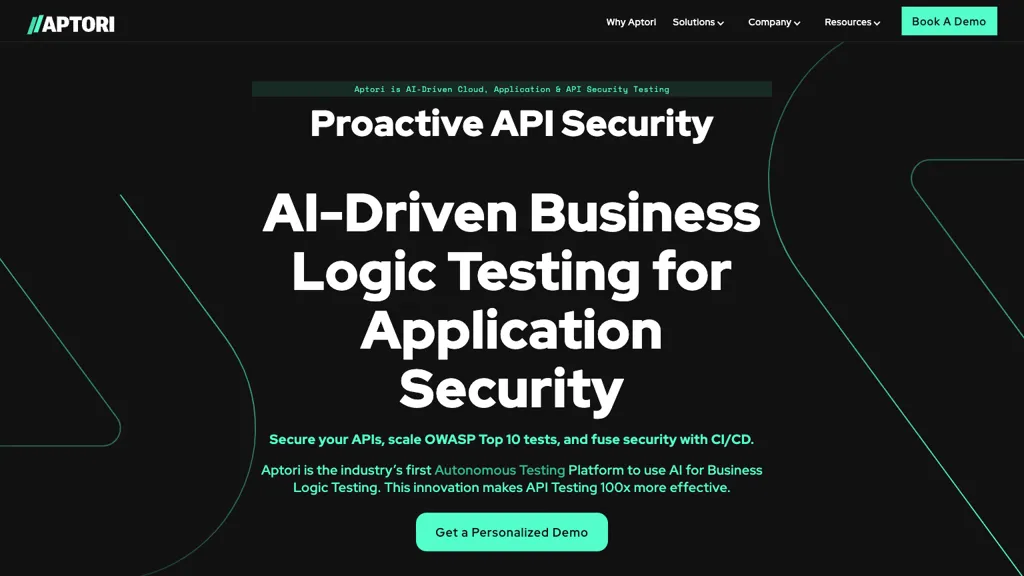What is Aptori?
Aptori is an innovative, AI-based tool offering Application Security Testing and API Security Solutions. This powerful platform addresses proactive API security and business logic testing with the aid of semantic reasoning technology and starts by acquiring a semantic model of the API of an application. Such a model itself creates and runs API tests autonomously to detect business logic flaws that will block the deployment of the vulnerabilities.
By leveraging AI-driven test automation, Aptori will fit itself within the software development lifecycle smoothly with continuous risk assessment, performance testing, and release confidence. It will ensure the security and compliance of applications and APIs; the security posture will be continuously monitored during the different stages of development and deployment.
Key Features & Benefits of Aptori
Some of the many features and hence benefits of Aptori, which makes it number one choice for various users are:
- API security testing
- Business logic testing
- Semantic reasoning technology
- AI-driven test automation
- Continuous risk assessment
Aptori brings with it several benefits. It provides for efficient and comprehensive testing that allows users to identify and prevent business logic defects way before they hit production. Its unique selling proposition is the seamless integration of Aptori in the software development life cycle, keeping applications always secure and compliant.
Use Cases and Applications of Aptori
Aptori can be applied in a number of scenarios to enhance the levels of security and compliance:
- Proactively test the security of APIs by creating and auto-executing API tests that are driven by a semantic model of the application. The model assists with describing vulnerabilities and business logic flaws prior to the ability to exploit them.
- Integrate Aptori into your SDLC for real-time risk assessment and performance testing, thereby assuring secure and compliant applications and APIs through all development and deployment phases.
- Leverage test automation with AI to build the much-needed confidence to release, by quickly detecting and preventing defects at the business logic level to provide security against security threats and raise the overall security posturing of the application.
Aptori can assist industries and sectors in the development of software, cybersecurity, and compliance. The users for whom Aptori will be beneficial are, respectively, developers, security engineers, DevOps teams, and compliance officers.
How to Use Aptori
Using Aptori is quite simple, for the following steps involved:
-
Setup:
Integrate Aptori into your ongoing software development lifecycle to begin the continuous risk assessment process in motion. -
Test Generation:
Aptori will develop a semantic model of the application’s API using its semantic reasoning technology, and then it will automatically generate and run the API tests. -
Analysis:
Observe the results of the tests to realize where the vulnerabilities in the business logic are. -
Improvement:
Continuously improve your application security posture by acting upon the actionable insights generated by Aptori’s tests.
Good best practice is to integrate Aptori in the early stages of development for the best outcome in identifying and mitigating all kinds of security risks.
How Aptori Works
Aptori is built upon complex semantic reasoning technology for the development of the semantic model toward an application’s API. This model then serves as a foundation for autonomous creation and execution of API tests. In addition, the core technology based on AI-driven algorithms supports continuous risk assessment and performance testing, integrated with the software development lifecycle.
It involves Aptori setup, generation of tests, analysis of results, and improvement of Aptori based on the derived insights. This continuous loop makes sure that the application is kept secure and compliant right from development through deployment.
Aptori Pros and Cons
Like any tool, Aptori has its share of pros and cons:
-
Pros:
The deep and high level of testing efficiency, easy integration into the SDLC, non-stop risk assessment, AI-based automation of tests. -
Cons:
For some users, the setup and learning curve may be steep and there may be dependencies on the accuracy of the semantic model it comes up with. In general, user feedback has been positive, with many praising its identification of business logic defects and the strengthening of security posture in general.
Conclusion on Aptori
In short, Aptori is a strong AI-driven tool for security testing of applications and APIs. Its unique technology in semantic reasoning, combined with AI automation, is the first pick for developers, security engineers, DevOps teams, and compliance officers. As much as there could be a learning curve at the start, continuous risk assessment, rapid testing, and solid security posture are worth a try.
In the future, with future updates and developments, Aptori will have more value and power than ever; hence this tool will be the best friend of many developers to ensure application security.
Frequently Asked Questions
-
Q:
In which lifecycle stage of software does Aptori integrate? -
Q:
What is semantic reasoning technology? -
Q:
What are the different user groups Aptori’s features and capabilities would offer support to? -
Q:
What are the major benefit/advantages of using Aptori? -
Q:
Are there any pitfalls of using Aptori?
Aptori integrates seamlessly during the SDLC stage into the software development life cycle, allowing continuous risk assessment and performance testing in all the stages into which the development and deployment of the application is broken down.
A: Aptori, semantic reasoning technology, creates a semantic model of APIs of an application and autonomously creates and runs API tests.
A: Some of the key user groups that can leverage Aptori’s features and capabilities include Developers, Security Engineers, DevOps Teams, and Compliance Officers.
Benefits include effective and thorough testing, its being totally embedded in the development cycle, continuous risk assessment, and AI-driven automation.
A: The setup and learning curve can be steep for some users, and some dependency in the generated semantic model may lack accuracy.










